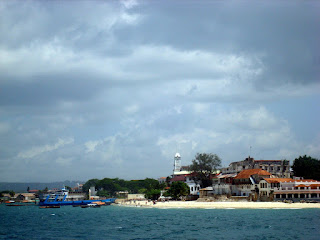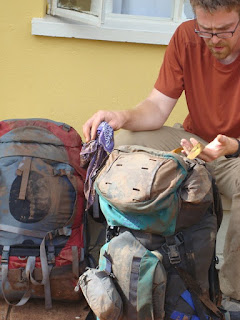Stone Town, the main city on the island, is an ancient city with winding narrow streets flanked by 3-4 storey, often crumbling buildings. A few main avenues through the town are wide enough to fit a car, but the majority of the streets are better navigated by motorcycle, bicycle or foot. These tiny lanes are often bustling with women in traditional Muslim dress, men pushing carts stacked high with a variety of goods for sale, children playing marbles in the dirt between ancient cobblestones. A modern grid layout was not a consideration of the urban planners of the 15th century, so on our arrival we worried we would quickly become lost when walking around. Luckily, our worries were in vain and exploring the cobbled lanes while poking our heads into shops became our favorite activity in Stone Town. Elaborate carved wooden doors are common features of residences and businesses throughout the town. We are told that historically a new building had its new door erected first and then the structure built around it.
Rich walking down the streets of Stone Town, Zanzibar.
Interesting old building.
Church and mosque side-by-side as seen from the streets of Stone Town.
One of many intricate doorways in Stone Town.
People (who normally have electricity; there are plenty on Zanzibar who don’t) went about their lives as normally as they could. Businesses, such as hotels, were kept going by petrol-powered generators - an expensive alternative. Our hotel’ generator allowed us to run a fan in our hotel room for a few hours in the evening - a welcome relief from the hot and humid weather.
To escape the heat of Stone Town, we headed to the east coast beach village of Jambiani. The beaches and turquoise ocean were beautiful. If not for the seaweed that commonly amasses on shore this time of year, the white sand would have been the archetype of a perfect beach. We spent one morning snorkeling off the dhow of Captain Haji and saw many beautiful fish, huge sea urchins, and one massive clam (and fortunately no reef sharks).
The view from Jambiani beach.
Jambiani beach is much quieter and more mellow than other more well-known party-beaches on the other side of the island. The beach is lined with small bungalow-style hotels and we had the pleasure of taking long walks on the beach in front of them (really!). In the evening time it was common to weave in and out of the beach soccer games of young men, coached soccer practices of boys, and keep-away games of even younger boys. After dark, we decided that here at the beach there was at least one benefit of the island-wide blackout…floodlights would have ruined the ambience.
To break up the days of lazing on the beach, we took a day trip to Jozani Forest Reserve - an old growth forest and mangrove swamp in the center of the island. During our visit, we huddled under umbrellas while Zanzibar red colobus monkeys huddled under leaves of nearby trees to escape a tropical rainstorm. After a very un-Christmasy Christmas spent on the beach, we returned to Stone Town for a couple more days, one of which was partially devoted to a Spice Tour. Though spices were historically imported to Zanzibar, nowadays there are many spice farms on the island. We strolled through one of these farms while munching on fruits such as breadfruit, pineapple, and rambutan right off the tree, and got to learn about and see the plants from which cardamom, nutmeg, cinnamon, vanilla, and cloves are harvested. After the farm tour we chowed down a locally-prepared meal incorporating many of the spices - it was delicious, and a great way to spend our last day in Zanzibar.
Zanzibar red colobus monkey at Jozani Forest.
Walking through the forest at Jozani.
Carissa rocking some palm-leaf specs.
Nutmeg and mace.
Peppercorns.
Rich before and after his haircut on Zanzibar.
The view of Stone Town from the Sea Bus ferry to Dar Es Salaam.




































